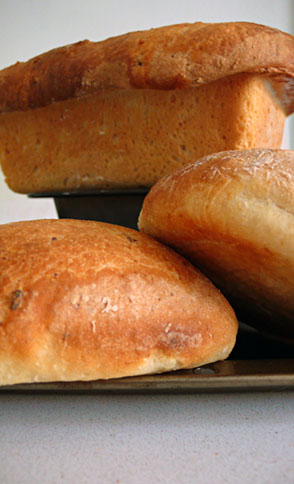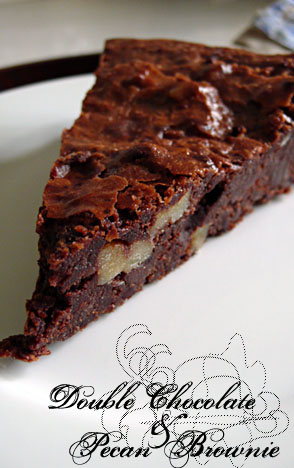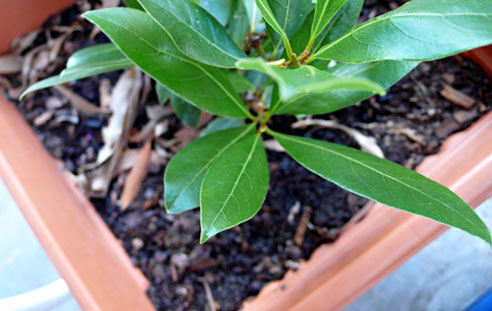Daring Bakers Challenge : Potato Bread
No secret here : I adore baking bread. I love kneading the dough, watching it rise, marvelling as it turns from a pale blob into a golden orb in the oven, and the aroma, oh the aroma!
So I was thrilled when Tanna of My Kitchen in Half Cups chose a Tender Potato Bread recipe as the Daring Bakers’ November Challenge.
What a challenge it was indeed. Being mindful of not adding too much flour during the kneading process, my dough ended up being very soft and moist and for the most part, quite hard to handle. When I started, this crazy Jabba the Hutt-like dough flowed from the bowl in which it was conceived, onto the floured bench top. I proceeded to massage it, and it continued to suck up copious amounts of flour, relentlessly. Ten minutes later, there seemed to be no end in sight, as it stuck to everything – my hands, clothes, bench, bits of equipment. Jabba’s revenge. At this point, I was starting to doubt that the end result would be in my favour. Potato bread I will not be eating today, I muttered, easing Jabba into a bowl to proof (which it did, copiously, up and over the sides : clean-up on aisle 3!).
Luckily, my misgivings were unfounded. This bread is simply delightful. When baked, it has a crisp golden brown top with a soft, very flavoursome (very potatoey) interior. Just as Tanna had promised. Fresh from the hot oven, the rolls are tantalising. The next day, the loaf made for a great breakfast, when cut into doorstopper-sized slices. After toasting, they acquired a pleasing aroma and crispness that reminded me of the bread’s initial splendour when it was first pulled from the oven.
Tender Potato Bread :
(from Home Baking: The Artful Mix of Flour & Tradition Around the World by Jeffrey Alford and Naomi Duguid; adaptations by Tanna of My Kitchen in Half Cups)
4 medium to large floury (baking) potatoes, peeled and cut into chunks.
4 cups (950 ml) water, reserve cooking water
1 tablespoon plus 1 teaspoon salt
2 teaspoons active dry yeast
6 ½ cups to 8 ½ cups (1 kg to 1350g) unbleached all-purpose
1 tablespoon unsalted butter, softened
1 cup (130g) whole wheat flour
Making the Dough:
Put the potatoes and 4 cups water in a sauce pan and bring to boil. Add 1 teaspoon salt and cook, half covered, until the potatoes are very tender.
Drain the potatoes, save the potato water, mash the potatoes well.
Measure out 3 cups(750ml) of the reserved potato water. Add extra water if needed to make 3 cups. Place the water and mashed potatoes in the bowl you plan to mix the bread dough in. Let cool to lukewarm (70-80°F/21 – 29°C) – stir well before testing the temperature – it should feel barely warm to your hand. You should be able to submerge you hand in the mix and not be uncomfortable.
Add yeast to 2 cups all-purpose flour and whisk. Add yeast and flour to the cooled mashed potatoes & water and mix well. Allow to rest/sit 5 minutes.
Sprinkle in the remaining 1 tablespoon salt and the softened butter; mix well. Add the 1 cup whole wheat flour, stir briefly.
Add 2 cups of the unbleached all-purpose flour and stir until all the flour has been incorporated.
Turn the dough out onto a generously floured surface and knead for about 10 minutes, incorporating flour as needed to prevent sticking. The dough will be very sticky to begin with, but as it takes up more flour from the kneading surface, it will become easier to handle; use a dough scraper to keep your surface clean. The kneaded dough will still be very soft. Place the dough in a large clean bowl or your rising container of choice, cover with plastic wrap or lid, and let rise about 2 hours or until doubled in volume.
Turn the dough out onto a well-floured surface and knead gently several minutes. It will be moist and a little sticky.
Forming the Bread:
Divide the dough into 2 unequal pieces in a proportion of one-third and two-thirds (one will be twice as large as the other). Place the smaller piece to one side and cover loosely.
To shape the large loaf:
Butter a 9 x 5 x 2.5 inch loaf/bread pan. Flatten the larger piece of dough on the floured surface to an approximate 12 x 8 inch oval, then roll it up from a narrow end to form a loaf. Pinch the seam closed and gently place seam side down in the buttered pan. The dough should come about three-quarters of the way up the sides of the pan. Cover with plastic wrap and let rise for 35 to 45 minutes, until puffy and almost doubled in volume.
To make a small loaf with the remainder:
Butter an 8x4X2 inch bread pan. Shape and proof the loaf the same way as the large loaf.
Baking the bread:
Preheat the oven to 230’C. Dust risen loaves and rolls with a little all-purpose flour or lightly brush the tops with a little melted butter or olive oil (the butter will give a golden/browned crust). Slash loaves crosswise two or three times with a razor blade or very sharp knife. For the first 10 minutes of baking time, bake the loaves at 230’C, then turn the oven down to 190 °C for the remaining time. Bake the small loaf for a total of 40 minutes, and the large loaf for a total of 50 minutes. Then remove the loaves from the pans and return to the oven for another 5 to 10 minutes. The corners should be firm when pinched and the bread should sound hollow when tapped on the bottom.










